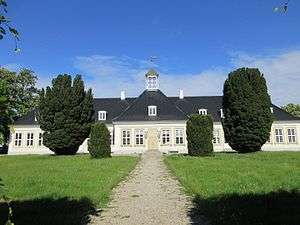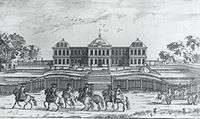Sophienberg

Sophienberg is a former royal summer retreat located on the Coast Road in Rungsted, Hørsholm Municipality, some 20 km north of central Copenhagen, Denmark. It is now operated as a venue for meetings and smaller conferences.
History

Sophienberg was built by king Christian VI and queen Sophie Magdalene. They had alreadu almost completed the much larger Hirschholm a few km away but wanted a hideaway closer to the coast from where it would be possible to enjoy the view of the water and the passing ships. Court architect Nicolai Eigtved began the construction of a small pavilion in 1742 but an expansion began immediately after its completion and the house was therefore not completed until 1746. The Baroque-style house had a five bay median risilit topped by a copper clad dome and a projecting four-bay pavilion at each end of the facade.[1]

In 1777, Sophienberg was the setting for some of the events during the affair between Struense and the queen. In 1780, Christian VII gave Sophienberg to his half brother, Frederick who expanded the estate significantly through the acquisition of more land. Sophienberg was acuited by colonel Arnoldus von Falkenskiold in 1797. He improved the management of the land but the former royal residence was far too big for his needs and in 1808–09 he removed the upper floor and one third of the ground floor. The surplus building materials were sold to constructors active in the rebuilding of Copenhagen following the British bombardment of the city in 1807. The house then changed hands many times over the following decades. Frederik Horsens Block purchased the property in 1872. He had returned from Hong Kong in 1845 and was also the owner of nearby Kokkedal House. The composer Peter Lange-Müller, Block's son-in-law, inherited Sophienberg in 1897 and lived there until his death in 1922. One of the couple's three daughters then took over the house which was listed in 1964.[2]
Th new owner completed a renovation of the building in 1990. The engineer Gunner Ruben purchased it in 2006.
References
- ↑ "History". Sophienberg Slot. Retrieved 8 January 2015.
- ↑ "Sag:Kulturstyrelsen". Kulturstyrelsen. Retrieved 8 January 2015.
External links
| Wikimedia Commons has media related to Sophienberg Palace. |
Coordinates: 55°53′58″N 12°31′58″E / 55.8995°N 12.5328°E